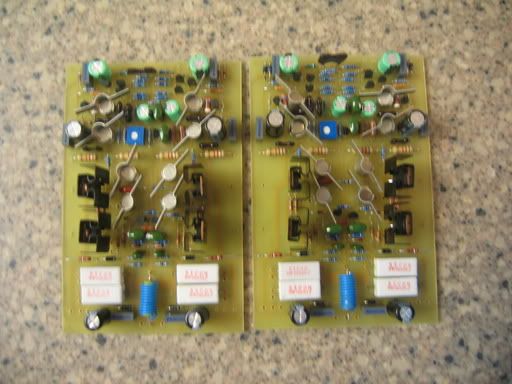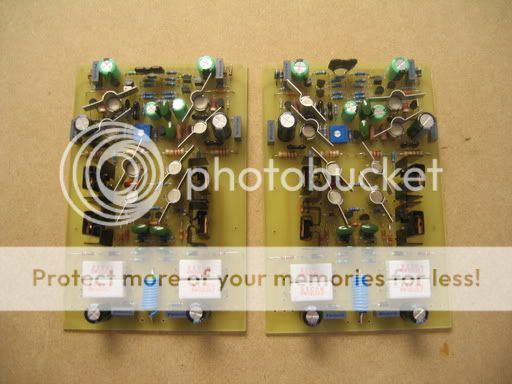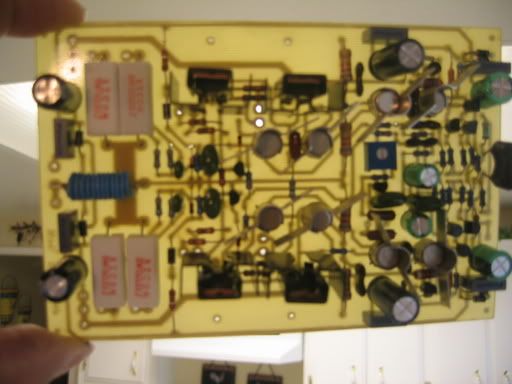measure the voltage across the resistor. If it drops to 20V or less, then your leakage current is <2 mA, and you are done.
I hadn't heard of the half voltage reforming before, which isn't to say that it won't work. I used rated voltage on some old caps and a 20K/3W resistor.
I hadn't heard of the half voltage reforming before, which isn't to say that it won't work. I used rated voltage on some old caps and a 20K/3W resistor.
I am not an expert, Bob maybe has a lot more experience.
The way it was explained to me was that it is better to do it a couple of times at half voltage instead of going to peak voltage at once.
Once the cap is in the amp and voltage on it, the cap is strong enough to have full voltage on it and get back in shape fully.
As long as the charging current per cap is low,it would be the fastest way to do them all at the same time, at only a few mA per cap you'll only need a small powersupply anyway.
Given that you have a variac you might consider steps: half voltage- full voltage.
The way it was explained to me was that it is better to do it a couple of times at half voltage instead of going to peak voltage at once.
Once the cap is in the amp and voltage on it, the cap is strong enough to have full voltage on it and get back in shape fully.
As long as the charging current per cap is low,it would be the fastest way to do them all at the same time, at only a few mA per cap you'll only need a small powersupply anyway.
Given that you have a variac you might consider steps: half voltage- full voltage.
I don't have a lot of experience reforming caps. I've heard some hard to verify stories about operating at less than rated voltage reduces the ability of the dielectric to withstand higher voltages. It sort of makes sense to me, and you won't blow anything up with 5 mA or so at solid state voltages.
If they aren't too bad, you migt even be able to reform them just by turning up the variac slowly, but without a current limiting resistor you run the risk of blowing them up.
The electrolyte is actually a conductor, it forms the dielectric with by depositing a film of insulating material on one of the plates. That's how you get such a high capacitance/volume - very thin dielectric and large surface area. I don't quite understand the chemistry of it, but this should be close.
Too much current too soon could cause arcing internally before the dielectric forms. The current limiting resistor prevents too much arcing.
****** Caution about my previous post - the 20V =OK only applies when using a 10K series resistor. For other resistances just use Ohms law to determine when the current is a few mA. If you cannot get the current to drop under 5 mA, then consider a new capacitor. You should see the current start to drop fairly quickly.
Once you have your reformed caps in circuit, check that the ripple voltage is about what you'd expect (model in PSUD, etc.). I had a pair of old caps in my leach amp. One rail at idle showed a few mV of ripple, the other about 3V (Just set your meter to AC and measure the rails) Time for new caps. You'll probably see a few volts of ripple at full power, but at normal class AB idle you shouldn't have more than millivolts.
If they aren't too bad, you migt even be able to reform them just by turning up the variac slowly, but without a current limiting resistor you run the risk of blowing them up.
The electrolyte is actually a conductor, it forms the dielectric with by depositing a film of insulating material on one of the plates. That's how you get such a high capacitance/volume - very thin dielectric and large surface area. I don't quite understand the chemistry of it, but this should be close.
Too much current too soon could cause arcing internally before the dielectric forms. The current limiting resistor prevents too much arcing.
****** Caution about my previous post - the 20V =OK only applies when using a 10K series resistor. For other resistances just use Ohms law to determine when the current is a few mA. If you cannot get the current to drop under 5 mA, then consider a new capacitor. You should see the current start to drop fairly quickly.
Once you have your reformed caps in circuit, check that the ripple voltage is about what you'd expect (model in PSUD, etc.). I had a pair of old caps in my leach amp. One rail at idle showed a few mV of ripple, the other about 3V (Just set your meter to AC and measure the rails) Time for new caps. You'll probably see a few volts of ripple at full power, but at normal class AB idle you shouldn't have more than millivolts.
Thanks guys,
The bringing it up slowly makes sense if the dielectric needs to form. Since I have a variac, that is a very simple thing for me to do.
It seems that sometime earlier someone was telling me to "form" the cas before I used them. I wasn't sure what hey meant at the time. I suppose now that they were refering to this. Seems that they recommended over charging them for a small period. I think he said to run the variac up to 140VAC for a while. I'll have to see if I can find that post. It was a while back, and I don't remember what thread it was in.
Do either of you see any benifit or problems with running the voltage a little higher for a spell?
Thanks, Terry
The bringing it up slowly makes sense if the dielectric needs to form. Since I have a variac, that is a very simple thing for me to do.
It seems that sometime earlier someone was telling me to "form" the cas before I used them. I wasn't sure what hey meant at the time. I suppose now that they were refering to this. Seems that they recommended over charging them for a small period. I think he said to run the variac up to 140VAC for a while. I'll have to see if I can find that post. It was a while back, and I don't remember what thread it was in.
Do either of you see any benifit or problems with running the voltage a little higher for a spell?
Thanks, Terry
I've also heard that running them slightly over voltage might help, but that doesn't make sense to me unless you are really pushing the limits of rated working voltage. Like 74 volt rails and 80 volt caps - try it at your own risk, and expect reduced cap life. 😉
Believe me, I have no desire of blowing anything up. That's why I'm asking questions first.
Blessings, Terry
Blessings, Terry
Well, I finished populating my boards.
Here are a couple of pictures.



Now on to drilling the heatsinks and building the PSU. 😀
Blessings, Terry
Here are a couple of pictures.



Now on to drilling the heatsinks and building the PSU. 😀
Blessings, Terry
capacitor question ?
hello , I have 25 cornell 12000uf 80v 380l123m080a072's . They are rated at 100vdc surge with max esr ohm at 25 c at 120hz .020 and 20k hz .012 with ripple amps at 120hz of 8.1 and 9.0 at 120k at 85c.Will these work for low tim power supply ?they are snap in 35mm x 70mm
hello , I have 25 cornell 12000uf 80v 380l123m080a072's . They are rated at 100vdc surge with max esr ohm at 25 c at 120hz .020 and 20k hz .012 with ripple amps at 120hz of 8.1 and 9.0 at 120k at 85c.Will these work for low tim power supply ?they are snap in 35mm x 70mm
T1 - The power supply voltages should be in the range (+ and -) 56 V to 59 V with no load on the amplifie.
If this is the case, then those caps will work just fine.
Prosit
If this is the case, then those caps will work just fine.
Prosit
Thank You
Dont know how I got in this thread?Yes i have adel 40x40 transformer.I was hoping those caps would work . I bought some from that vendor everyone was wonder about so we will see , I have some 10000 uf I got from digikey also .I will try both.I will bring up slow with variac like all suggested , I wont go over rated voltage though ,If I blow them up in hotel they may make me stop building stuff.They look at me funny because I have drill press,rotary tools and pcb etching stuff already.i think they think I have meth lab or something.
Dont know how I got in this thread?Yes i have adel 40x40 transformer.I was hoping those caps would work . I bought some from that vendor everyone was wonder about so we will see , I have some 10000 uf I got from digikey also .I will try both.I will bring up slow with variac like all suggested , I wont go over rated voltage though ,If I blow them up in hotel they may make me stop building stuff.They look at me funny because I have drill press,rotary tools and pcb etching stuff already.i think they think I have meth lab or something.
pnp
I had same problem with press and peel also .The edges and some small traces didnt stick.I also used pen from radio shack with no problems.Just need to look reel close after you iron.I got one of those tanks with bubble maker.Doesnt work that well , worked better when i moved them around by hand.Oh yeah , its alot less messing if you havent been drinking beer.Lucky I have a large rubber door matt over table.I got mad when i wasted 2 of those pnp sheets because they didnt stick , not sure why it was the second set I used with diferent clad boards.i spent like 300 bucks for parts and got mad cause I wasted 2 dollars kinda stupid huh but it went so well first time.
I had same problem with press and peel also .The edges and some small traces didnt stick.I also used pen from radio shack with no problems.Just need to look reel close after you iron.I got one of those tanks with bubble maker.Doesnt work that well , worked better when i moved them around by hand.Oh yeah , its alot less messing if you havent been drinking beer.Lucky I have a large rubber door matt over table.I got mad when i wasted 2 of those pnp sheets because they didnt stick , not sure why it was the second set I used with diferent clad boards.i spent like 300 bucks for parts and got mad cause I wasted 2 dollars kinda stupid huh but it went so well first time.
I'm populating my Leach (regular) boards, and ran into a problem. I used all suggested parts from digikey (listed part numbers). Here's the problem, I assume someone else has figured this out...
From the list:
"C6 - Either a single non-polar capacitor or two polar capacitors can be used for C6. I recommend the non-polar capacitor. In this case, use a 220 uF, 16 V bi-polar electrolytic in the holes for C6A (DigiKey/Panasonic P1168-ND, 0.2 inch hole spacing) and solder a short circuit jumper in the holes for C6B. (Failure to install this jumper will result in the loss of all bass response.) For two polar capacitors, use a 330 uF, 16 V radial electrolytic for C6A and C6B (DigiKey P10246-ND). "
I just went ahead and ordered P1168-ND as it seemed to be the preferred part. What I don;t get is that he says "single non-polar capacitor" but the single cap he lists is a bi-polar cap. I am most confused, so I'm holding off installing these until someone get help me get my head screwed on strainght. Does the jumper somehow render a bi-polar cap non-polar?
tia
From the list:
"C6 - Either a single non-polar capacitor or two polar capacitors can be used for C6. I recommend the non-polar capacitor. In this case, use a 220 uF, 16 V bi-polar electrolytic in the holes for C6A (DigiKey/Panasonic P1168-ND, 0.2 inch hole spacing) and solder a short circuit jumper in the holes for C6B. (Failure to install this jumper will result in the loss of all bass response.) For two polar capacitors, use a 330 uF, 16 V radial electrolytic for C6A and C6B (DigiKey P10246-ND). "
I just went ahead and ordered P1168-ND as it seemed to be the preferred part. What I don;t get is that he says "single non-polar capacitor" but the single cap he lists is a bi-polar cap. I am most confused, so I'm holding off installing these until someone get help me get my head screwed on strainght. Does the jumper somehow render a bi-polar cap non-polar?
tia
non-polar = bi-polar
Most electrolytic caps are polar, so you have to have a + and a - pin.
The bi-polar is like a film cap, there is no + or -, byt it's still an electrolytic cap.
I hope you understand
\Jens
Most electrolytic caps are polar, so you have to have a + and a - pin.
The bi-polar is like a film cap, there is no + or -, byt it's still an electrolytic cap.
I hope you understand
\Jens
If you look at my boards you'll see that I opted fopr the two polar caps. Not sure why. You'd think if the guy who designed the amp said to use less I would, but I didn't.
Blessings, Terry

Blessings, Terry
That last picture looks smashing, Terry.
Maybe one day i'll build an open view amplifier with a couple of bright high power leds under the pcb to see the board traces.
I could watch the tube amps i built when they were glowing for hours.
Now i am off to raid a hotelroom filled with Cornell Dubelier's
Maybe one day i'll build an open view amplifier with a couple of bright high power leds under the pcb to see the board traces.
I could watch the tube amps i built when they were glowing for hours.
Now i am off to raid a hotelroom filled with Cornell Dubelier's
capacitor
Well we will find out if they really are cd capacitors. It was only 50.00 for 25 .I am kinda skeptical.But only way to findout was to get some.I just got email back from professor leach . I am gonna get some pcb's from him its only 25.00 for two low-tim.I am getting 8 .6 for amps and two to try different transistors in ,to hear the what they sound like.My ears are not that great ( 10 years helicopter avionics.) but they work pkay .
Well we will find out if they really are cd capacitors. It was only 50.00 for 25 .I am kinda skeptical.But only way to findout was to get some.I just got email back from professor leach . I am gonna get some pcb's from him its only 25.00 for two low-tim.I am getting 8 .6 for amps and two to try different transistors in ,to hear the what they sound like.My ears are not that great ( 10 years helicopter avionics.) but they work pkay .
I bought 4 boxes of CG Mallory's for 200.
Not 100 volts, only 50.
But brandnew, 78000 uF, and 12 in the original box.
You never know, you may have done a good deal, $2 the piece is good trading. You sure you're not Dutch ?
I was in a helicopter a couple of times, after 10 years you should count your blessings that you can hear at all.
No problem, you just need a bigger amplifier !
Whats in those cookies, WAH ?
Not 100 volts, only 50.
But brandnew, 78000 uF, and 12 in the original box.
You never know, you may have done a good deal, $2 the piece is good trading. You sure you're not Dutch ?
I was in a helicopter a couple of times, after 10 years you should count your blessings that you can hear at all.
No problem, you just need a bigger amplifier !
Whats in those cookies, WAH ?
- Status
- Not open for further replies.
- Home
- Amplifiers
- Solid State
- Have transformer, will build